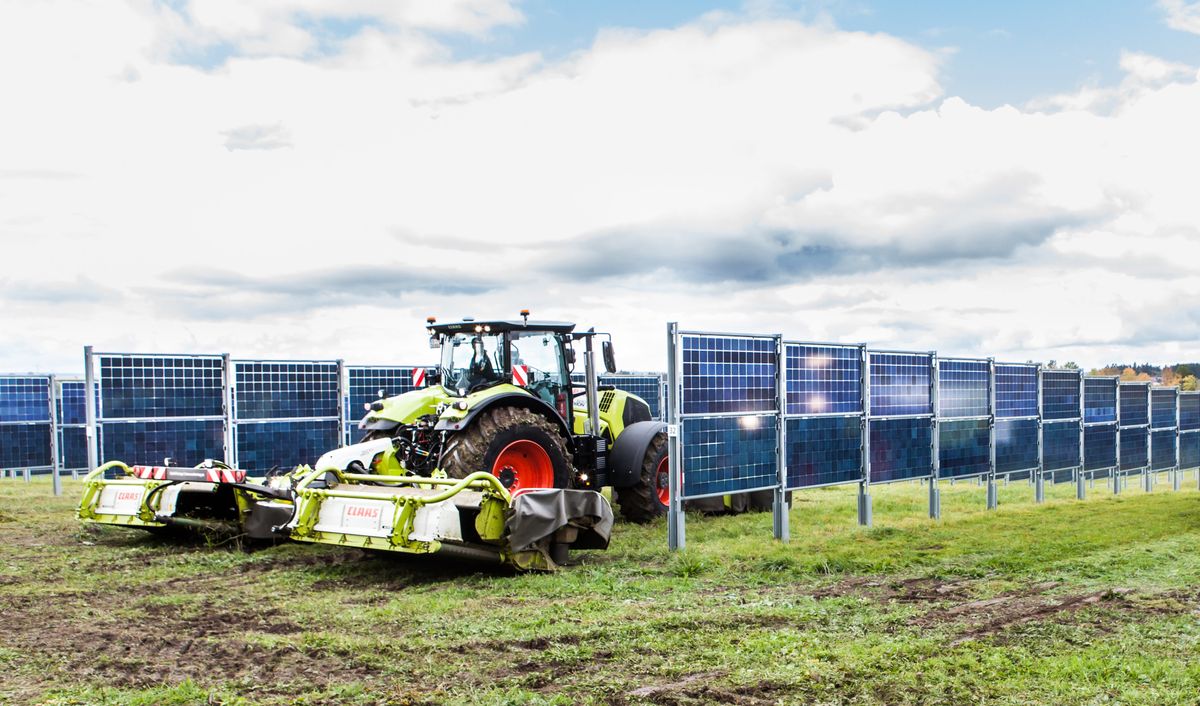The German startup Next2Sun is on a mission to install vertical solar panels alongside some unlikely neighbors, including crops like potatoes and hay. With several projects in Germany complete and a new installation in Vermont in the works, the company hopes to combine traditional farming with solar power—and use land for two purposes simultaneously.
Agrivoltaics, the term for using land for both farming and solar power, has the primary advantage of minimizing the overall need for land. The challenge is that traditional solar panels, which typically lie near the ground, don’t work for this purpose. The plants themselves need soil, sun, and space to grow, after all.
To deal with this problem, Next2Sun’s key focus is on special bifacial solar modules that are installed vertically and efficiently collect sunlight from both the front and back side of their panels. This strategy is especially helpful in areas where land is expensive and in regions and countries where space overall is limited. This approach could become a necessity: The U.S. Department of Energy has warned that the land used for solar power and agriculture is similar, meaning that the industries could come into conflict if solar usage continues to grow.
“In Germany, with high population density, it’s [been] about 10 years when the discussion started about how much land can we use for PV,” explains Heiko Hildebrandt, who is on the management board of Next2Sun, which was founded in 2015. “A lot of people are looking for solutions and obviously, agri-PV is a solution.”
Benefits of agrivoltaics
The more efficient use of land isn’t the only benefit of agrivoltaics, though. Vertical solar panels used on farmland can collect energy in the morning and evening, which counterbalances other solar plants, Hildebrandt explains. What’s more, vertical panels are less likely to be affected by snowstorms.
Researchers studying agrivoltaics have also argued that crops planted through agrivoltaics might be better protected from extreme weather, including heat and precipitation. And it works in the other direction, too: Incorporating vegetation can improve soil health where solar panels are installed, and grasses could support animal grazing, noted Madhu Khanna, a professor and the director of the Institute for Sustainability, Energy, and Environment at the University of Illinois Urbana-Champaign.
At least for Next2Sun, the concept has proved successful. After some experimentation, in 2018 the company commissioned its first demonstration in Germany, which combined farming for hay and silage with a solar module that could supply 2 megawatts. That’s enough, the company says, to support 700 households. Two years later, the company commissioned its first commercial plant, which combined a hay and silage farm (also based in Germany) with panels that provided more than 4 MW.
Now, the company is turning to the United States, starting with a new installation announced for Vermont. The project, a collaboration with a U.S. solar company called iSun, will cover nearly 4 acres and grow carrots, beetroot, and saffron crops. The project has support from the German Federal Ministry for Economic Affairs and Climate Action; construction will begin in early 2024.
Still, agrivoltaics comes with some limitations. While certain crops, like hay and potatoes, are a great fit for the technology, others, like corn, could end up blocking the panels. Not just any solar panel will work, either. Next2Sun’s agrivoltaics require bifacial solar panels that efficiently collect sunlight from both sides, which—before the company was officially founded—were somewhat hard to buy, Hildebrandt says. Solar panels for agrivoltaics also need to be tall, which can make them more expensive, says Khanna, of the University of Illinois Urbana-Champaign.
Meanwhile, there are still plenty of open questions for agrivoltaics projects overall. Farmers and developers need to partner and forge new contractual relationships for cost-sharing, explains Khanna, and also address questions about liability and insurance. At the same time, best management practices for actually deploying and using these kinds of systems still need to be developed.
“We need to better understand how hydrologic and ecological processes respond to the novel shading and water redistribution regimes that exist beneath and around photovoltaic arrays, in order to leverage synergistic opportunities through generation of co-benefits while preventing unintended—but not necessarily unpredictable—consequences,” says Steven Loheide, a water resources engineering professor at the University of Wisconsin Madison who has studied agrivoltaics.
- Tequila Sunrise: Big Benefit from Co-Locating Agave Crops and Solar Power ›
- Agrivoltaic Panels Allow Farmers to Harvest Energy ›
- Micro-CPV Solar Panels Boost Efficiency and Cut Costs - IEEE Spectrum ›
Rebecca Heilweil is a journalist focusing on emerging technology and technology policy. She has written for Wired, the Wall Street Journal, and Slate, among other outlets.
To find her elsewhere: https://twitter.com/rebheilweil



